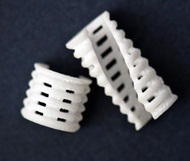 3D-printing has come to the rescue of severe cases of a childhood disease in which the windpipe is softened, leading to collapse of the airway and breathing failure, reports Medical News Today. Previously lacking any adequate intervention, tracheobronchomalacia has found an innovative fix in three babies whose condition presented them with little chance of reaching young childhood.
3D-printing has come to the rescue of severe cases of a childhood disease in which the windpipe is softened, leading to collapse of the airway and breathing failure, reports Medical News Today. Previously lacking any adequate intervention, tracheobronchomalacia has found an innovative fix in three babies whose condition presented them with little chance of reaching young childhood.
Researchers at the University of Michigan's CS Mott Children's Hospital in Ann Arbor say the three boys have become the "first in the world to benefit from groundbreaking 3D-printed devices" to stent their airways in such a way as to allow the supports to keep up with their growth. A follow-up of all three patients shows the personalised bioresorbable splint implants have worked with "promising results."
Paediatric tracheobronchomalacia (TBM) sees excessive collapse of the airways during breathing that can lead to life-threatening cardiopulmonary arrests (halted heart and breathing). The cartilage supporting the airway can strengthen as children with the condition grow, the study paper goes on to explain, but severe cases of the disease require aggressive treatment – and those children are at "imminent risk of death."
Before this new approach to provide an early treatment option for TBM, the only conventional therapies available also carried life-threatening complications of their own. Babies needed tracheostomy tube placement with mechanical ventilation, requiring prolonged hospitalisation, and complications often led to cardiac and respiratory arrest. For example, the rate of respiratory arrest owing to tube occlusion runs as high as 43% of paediatric tracheostomy procedures a year.
But none of the newly developed 3D-printed devices have caused any complications for the three children treated, including Kaiba, who at 3 months old was the first to receive the new technology, 3 years ago. The stents were also inserted into 5-month-old Ian and 16-month-old Garrett.
Designed to accommodate airway growth while preventing external compression over a period of time before bioresorption, the technology allows for the particular problem of radial expansion of the airway over the critical period of growth. "If a child can be supported through the first 24 to 36 months of tracheobronchomalacia, airway growth generally results in a natural resolution of this disease," write the authors.
[link url="http://www.medicalnewstoday.com/articles/293224.php"]Full Medical News Today report[/link]
[link url="http://stm.sciencemag.org/content/7/285/285ra64.abstract?sid=784e28cd-464d-441e-9048-be4e154d94bb"]Science Translational Medicine abstract[/link]
